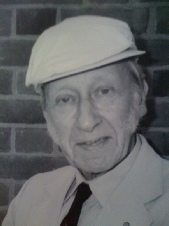





“47 Years in South Street”
Introduction
I was born at Laindon Common, Billericay on 10th August 1930 and I came to work in Rochford on a snowy day in January 1946. I began work in South Street and I have worked there ever since, not in the same building but never more than 75 yards from where I started. I have never been unemployed.
Now it is all coming to an end. I have been sorting out some of my papers in the office recently, most of which is destined for the Essex Record Office. I had a talk to John Smith at the Southend office, and like many other people he said "Are you going to write down your experiences?" I said I had thought about it but wondered who would read it. "That's not the point" I was told, “if it is written down it goes on record." I said I would think about it. Having thought, it does not seem such a bad idea. Local government and the lot of local government officers has changed a great deal since I started and I suppose what I have seen and done must interest someone. So let's see how I get on.
An inauspicious start in Rochford
I cannot exactly recall why I came to work at Rochford. I suppose that as I was attending college at Southend it was natural that I was directed to a job in that district. I knew Rochford a little, as we had relatives there, but I had only been into the town once, as my relatives lived in Ashingdon Road and the walk from the station did not take you through the town. I must have been about 12 at the time and walked down to Southend Road with my aunt to get something from Dr. Emery's surgery. As we passed that imposing building in South Street I noticed a board outside that said that a Morrison Aid Raid Shelter was on display in the building. I asked my aunt what the building was, and she said it was the Council Offices. Little did I know then how well I was to come to know that building.
When I got off the train on that morning in January 1946 to start my career in local government, I stepped right into about a foot of snow, so starting my career with wet socks. I made my way up to the offices, where I met George Marven who was sweeping snow off the steps. George was the caretaker, and we became and remained friends right up to his death in about 1970. I was taken round the offices by Miss Burrows, the Clerk's Secretary, and introduced to the rest of the staff, which in those days did not take very long. Then up to the Council Chamber to meet my work mate, Jim Abbott, who also became a friend.
Life in the Council Chamber
Yes, in those days the Clerk of the Council's Department was housed in the Council Chamber. We worked at desks ranged along the west wall, and on days when there were Council and Committee Meetings, which were then in the afternoon, we had to move out. In the morning of a Committee day you went round the offices to see who was off sick or out for the day and used his or her desk for the afternoon, taking with you as much work as you felt you could deal with. This was a far from satisfactory arrangement, but office space was sparse and we had to make the best of it.
The old Council Offices eventually became a Court House and then later the Masonic Hall. It has been extensively altered since the Council sold it in 1980, but in 1946 the accommodation consisted of six rooms and toilets downstairs, with the Council Chamber and five rooms upstairs. There was also a wooden building in the back yard which was used as the Drawing Office. There was no kitchen, and the tea, made by George Marven, was made on a gas stove which stood in a corner of the porch leading to the back yard, with a sink and draining board on the other side. Most of the rooms were heated by coal fires, the coal and wood being stored in a shed outside, where there was also a bicycle shed. The corridors were paved with flagstones which made the building very cold, especially in the winter, when the walls often ran with condensation. There were two wells in the building, their location given away by two iron rings in the flagstones. At some time in the early 1960’s the corridor floors were renovated and the flagstones, and the location of the wells, disappeared under thin concrete skim covered in floor tiles. I know roughly where they are, but who else will in the future?
In 1946 the Council was almost bereft of what we now know as technology. Apart from typewriters, the only other machine in the place was a Gestetner Duplicator. There were only eight telephones in the whole place, controlled by a switchboard situated in the Cashiers' Office, where the operator doubled as receptionist. Come to think of it, we all doubled as something. We of the Clerk's Department who worked in the Council Chamber had no telephone. If we had an incoming phone call, the operator summoned us by using an electric bell -
Duties in the Clerks Department
My duties were in the Clerk's Department and involved filing, the post, all of the office duplicating, including minutes and agenda, and anything else that was going. We worked from 9.00 to 1.00 and 2.15 to 5.30, and alternate Saturday mornings from 9.00 to 12.30. My salary worked out at about £2.15s (£2.75p) per week. The War had not been over for very long and almost everything, except work, was in short supply. We never had enough coal for the fires, the power was cut off during the middle of the day to save fuel, food was still rationed, petrol was rationed (though few people had a car) and stationery and office equipment was almost impossible to obtain.
Post-
There was little building work being done as there was hardly any building materials to be had, and you needed a licence for what you could get. But in spite of all this we were looking forward to a brave new world. The War was over for which we were all thankful, and life did have its compensations. We used to have lunch at the British Restaurant, which was in a building which stood on what is now the car park at 57 South Street. For those who are wondering what a British Restaurant was, it was an eating place established by the Government in almost every town of any size in Great Britain in 1940, the idea behind them being that they would provide cheap, but nourishing meals for working people. The food was generally plain, but in the case of Rochford generally well cooked and certain to fill you up. One of my duties was to visit the place every day with George Marven to collect the takings, and on these occasions I sometimes bought a corned beef sandwich. The difference between an ordinary corned beef sandwich and mine was however, that the corned beef would be about an inch thick, which was gratefully accepted by my mother as it provided a meal for the whole family. I recall once that Jim Abbott bought me a sausage roll from the Restaurant which had beautifully glazed puff pastry. It was not until I started to eat it that I discovered the "glaze" was glue.
The Officers of the Council
As I have said, the staff in 1946 was much smaller than it is now. The "head of paid service" as we call him now was the Clerk of the Council, Mr. Stanley Harris. He held the post from 1935 until 1964 and was one of the last of the old time Council Clerks. He was a good boss however and as long as you pulled your weight you had no cause to complain. The other Chief Officers were Mr. Norman Box, the Engineer and Surveyor, Mr. Robert Lynn, the Chief Financial Officer and Mr. Henry Jepson the (then styled) Sanitary Inspector. The Medical Officer of Health was Dr. John McDonald, who we shared with about seven other Councils in the area. Like myself, Mr. Harris was very keen on local history, and in latter years, following his retirement, we co-
Council Members
The members of the Council were then held very much at arms length and communication with them was generally only through Mr. Harris. There were no first name terms as there are now, and all male members were addressed as "Sir" and the ladies as "Madam". Some members were however quite friendly whereas others ignored you. I recall Mr. Percy Cottis as being one of the most friendly. Farmer, haulage contractor and many other things besides, "Percy George" as he was known round the town always had a kind word for me. On meeting days, George and I had to stand at the top of the stairs and open the Council Chamber doors for the members as they came in, and if necessary take their hats and coats and hang them up. I used to lean over the stair rail and see who was coming and say to George something like "stand to attention, here comes old So and So." The Chairman in 1946 was Mr. George Milbourn. He was a member of the well known Gt. Wakering farming family, although he lived in Rochford along the Stambridge Road. I used to go to his house sometimes to get his signatures on papers and documents, and he was always very courteous and displayed a great interest in what I was doing at the office.
Other members I remember well were Mr. Charles Muggleton, who was a builder in Ashingdon. In later years his son and Cleveland Johnson who was at one time the Council’s Housing Officer, took over the business which became the well known MBC Building Contractors. Also, the Rev. A.L. Harris, rector of Stambridge, and Bill Horner, one of the well known family in Rochford who had the butcher’s shop in the Square. At that time, two factors influenced the make up of the Council. One was that working conditions were not what they are now and people had difficulty in getting time off work to attend daytime meetings, and the other was that the Council meetings all commenced at 2.30 p.m. So the only people who could stand for the Council were, more or less, the retired or self employed.
History Remembered: David Collins
“47 Years in South Street”
